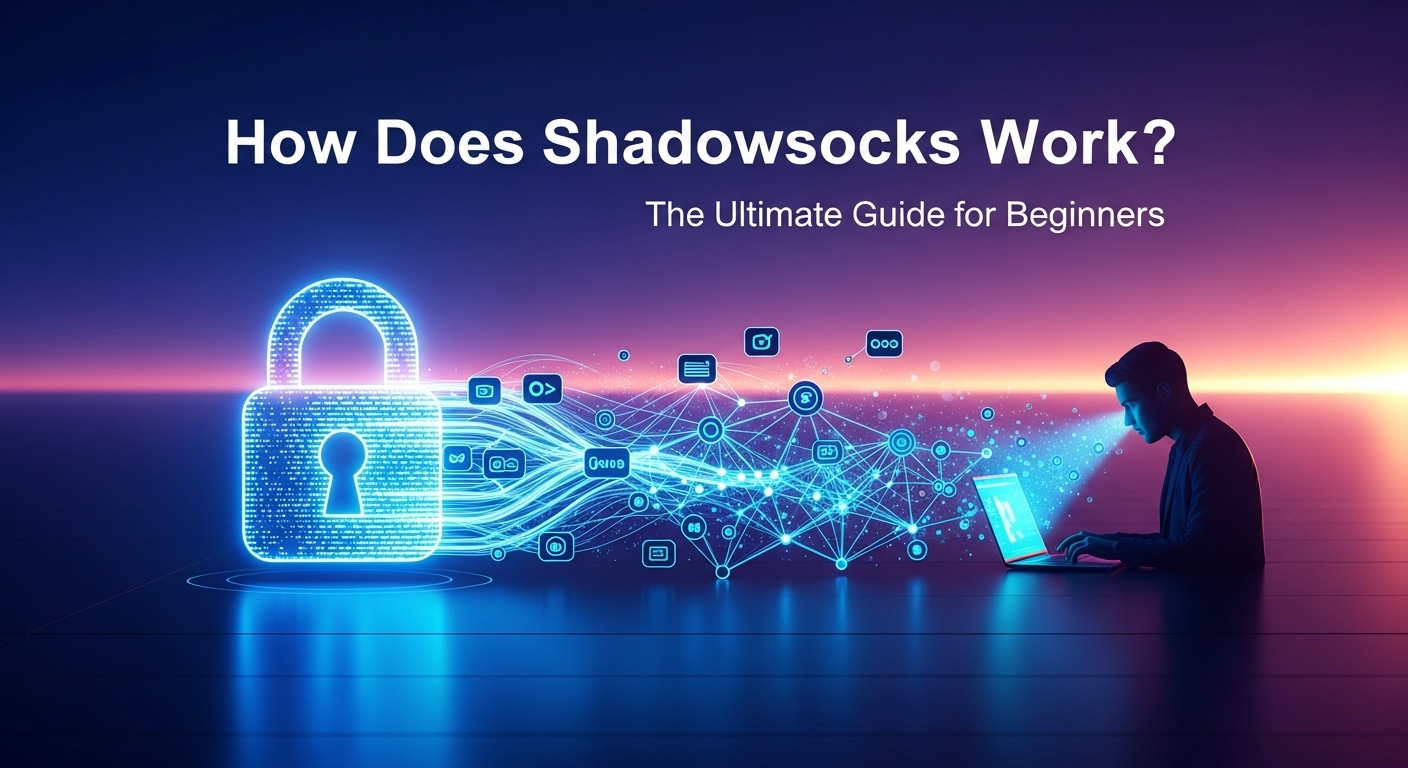In an era where digital borders are becoming increasingly rigid, the quest for an open and unrestricted internet has never been more relevant. Many users find themselves cut off from global information, services, and communication platforms due to aggressive online censorship. This has fueled the rise of circumvention tools, each with its own method of navigating these digital barricades. Among the most sophisticated and misunderstood of these tools is Shadowsocks. While often compared to VPNs, it operates on a fundamentally different principle, one built for stealth and efficiency. For anyone looking to understand this powerful technology, the central question is: how does Shadowsocks work? This guide will demystify the protocol, breaking down its inner workings, comparing it to other technologies, and providing a clear path for beginners to grasp its significance.
Table of Contents
ToggleWhat is Shadowsocks, Anyway? A Primer for the Uninitiated
Before diving into the technical mechanics, it's crucial to establish a clear understanding of what Shadowsocks is and, just as importantly, what it is not. At its core, Shadowsocks is an open-source, encrypted proxy project. It was initially created in 2012 by a Chinese programmer known by the pseudonym "clowwindy" with the specific goal of bypassing the Great Firewall (GFW) of China. Unlike a traditional proxy that simply relays your internet traffic, Shadowsocks wraps your data in a layer of industry-standard encryption, effectively disguising it from prying eyes and automated censorship systems.
The primary purpose of Shadowsocks is not total anonymity or comprehensive security in the way a full-fledged VPN is. Instead, its design philosophy prioritizes evasion and performance. It was engineered to be lightweight, fast, and incredibly difficult to detect. While a traditional HTTP or SOCKS5 proxy sends your data in the clear, making it easy for an Internet Service Provider (ISP) or a state-level firewall to inspect and block, Shadowsocks encrypts this proxy traffic. This makes it appear as meaningless, randomized data, allowing it to slip past censorship mechanisms that are trained to identify and block the specific protocols used by VPNs, like OpenVPN or IKEv2.
Think of it this way: a standard proxy is like sending a postcard. Anyone who intercepts it can read its contents. A VPN is like sending a package in an armored truck with a clear "SECURE DOCUMENT" label; it's very secure, but its presence is obvious. Shadowsocks, however, is like sending a coded message inside a generic-looking business envelope. The envelope itself doesn't attract attention, and even if it's opened, the contents are indecipherable without the secret key. This focus on "looking like nothing" is the secret to its success in heavily restricted network environments.
The Core Mechanism: How Does Shadowsocks Work Under the Hood?
Understanding the functionality of Shadowsocks requires looking at it as a two-part system: a client application running on your device (e.g., your computer or smartphone) and a server component running on a remote server you control or subscribe to. The magic happens in the communication dance between these two components. Your internet traffic doesn't go directly to the website you want to visit; instead, it is cleverly rerouted and disguised through your Shadowsocks server, which acts as a middleman.
This client-server architecture is fundamental. The client's job is to capture the traffic from specific applications on your device, encrypt it, and send it to the server. The server's job is to receive this encrypted data, decrypt it to see your intended destination, fetch the content from that destination (e.g., Google.com), encrypt the content it receives, and send it back to your client. The client then decrypts this final package and displays the content in your application.
This entire process is designed to defeat a sophisticated form of network filtering called Deep Packet Inspection (DPI). DPI systems are algorithms that inspect the actual data (packets) flowing through a network to identify protocols and block them. Because Shadowsocks traffic is encrypted and does not have a recognizable "fingerprint" like many VPN protocols, it often blends in with regular HTTPS traffic, making it exceptionally difficult for DPI systems to flag and terminate the connection.
The Client-Side Operation: Encapsulating Your Traffic
The process begins on your local device. After you install a Shadowsocks client and configure it with your server's details (IP address, port number, password, and encryption method), the client starts listening for network connections from applications you've designated, typically your web browser. When you try to access a blocked website, the Shadowsocks client intercepts this request before it leaves your device.
Instead of sending the request directly to the internet, the client first packages it using the SOCKS5 protocol. A SOCKS5 proxy is a versatile internet protocol that can handle various types of traffic. The client essentially tells your browser, "Send all your traffic to me, and I'll handle it." Once it has the SOCKS5-packaged data, the client then applies a powerful layer of encryption using a pre-shared key (your password) and a chosen encryption algorithm. Modern Shadowsocks implementations use highly secure Authenticated Encryption with Associated Data (AEAD) ciphers, such as AES-256-GCM or Chacha20-IETF-Poly1305, which provide confidentiality, integrity, and authenticity, preventing both eavesdropping and data tampering. This encrypted packet is then sent to your remote Shadowsocks server.
The Server-Side Relay: Decryption and Forwarding
When the encrypted packet arrives at your remote Shadowsocks server (which is strategically located in a country with no internet censorship), the server uses the same pre-shared key (password) and encryption method to decrypt the data. Once decrypted, the server can see the original SOCKS5 request, which contains the actual destination you wanted to reach, for example, `www.youtube.com`.
Now acting on your behalf, the Shadowsocks server makes a direct, un-proxied connection to `www.youtube.com`. From YouTube's perspective, the request appears to be coming from the server's IP address, not yours. This is how your location is masked and how you gain access to geo-restricted content. The server fetches all the data for the YouTube homepage—HTML, images, scripts, and video streams. This step is crucial; the remote server is the one doing the "browsing" of the open internet, completely bypassing the firewall that sits between you and it.
The Return Journey: Disguising the Data
Once the Shadowsocks server receives the requested content from the destination website (YouTube), it doesn't just send it back to you in the clear. Doing so would allow the censorship firewall to inspect the returning data, identify it as coming from a blocked service, and terminate the connection. Instead, the server takes the content, encrypts it using the same password and algorithm, and sends the encrypted packets back to your Shadowsocks client.
Your client receives this stream of encrypted data. Because it has the secret key, it seamlessly decrypts the packets in real-time, reassembles the content, and passes it to your web browser for display. To your ISP or any a network monitor, the entire exchange simply looks like a continuous stream of encrypted gibberish between your computer and a single, random server. They cannot determine that you are secretly accessing YouTube, Twitter, or any other blocked service. This completes the circumvention loop, providing a fast and stealthy connection to the open internet.
Shadowsocks vs. VPN: A Head-to-Head Comparison
One of the most common points of confusion for beginners is the distinction between Shadowsocks and a Virtual Private Network (VPN). While both are used to bypass censorship and enhance privacy, they are architecturally different and optimized for different use cases. A VPN is designed to create a secure, encrypted "tunnel" for all of your device's internet traffic. It operates at the operating system's network level (Layer 3), rerouting everything from your browser and email client to your system updates through the VPN server.
Shadowsocks, on the other hand, is a proxy that typically operates at the application level (Layer 5). This means it is more granular. You can configure it to only proxy traffic from specific applications, like your web browser, while allowing other applications, like online games or local services, to connect directly to the internet. This selective routing is one of its key advantages, as it prevents unnecessary latency for applications that don't need to be proxied. While some VPN clients now offer "split-tunneling," this is the default mode of operation for Shadowsocks.
The biggest difference, however, lies in their protocols and stealth. VPNs use standardized protocols like OpenVPN, IKEv2/IPsec, and WireGuard. While highly secure, these protocols have distinct signatures that DPI systems can be trained to recognize and block. This has led to an ongoing cat-and-mouse game where censorship systems get better at detecting VPNs. Shadowsocks was designed from the ground up to be protocol-less and ambiguous. Its traffic is deliberately made to resemble the ubiquitous HTTPS traffic that powers the modern secure web, making it much harder to single out and block without causing massive collateral damage to legitimate internet traffic.
| Feature | Shadowsocks | VPN (Virtual Private Network) |
|---|---|---|
| Primary Goal | Circumvention and stealth evasion. | Comprehensive security and privacy. |
| Operation Level | Application Layer (Proxy). | Network Layer (OS-level tunnel). |
| Traffic Scope | Typically per-application (selective). | System-wide (all traffic by default). |
| Stealth | Very High. Designed to be indistinguishable from HTTPS traffic to evade DPI. | Moderate to High. Standard protocols (e.g., OpenVPN) can be detected and blocked. |
| Performance | Generally faster with lower overhead due to simpler encryption/handshake. | Can have higher overhead, potentially impacting speed and latency. |
| Ease of Use | Requires more setup (finding/setting up a server and client). | Commercial services are very user-friendly (install and click connect). |
| Security Scope | Secures traffic between client and server. Provider can see unencrypted traffic. | Encrypts all traffic in a tunnel. Top providers have strict no-logs policies. |
Key Features and Advantages of Using Shadowsocks
Shadowsocks has maintained its popularity in the face of evolving censorship tactics due to a unique set of features that make it particularly effective. These advantages are centered around its core design principles of stealth, performance, and flexibility, offering a compelling alternative to other tools.
Superior Stealth and Evasion Capabilities
The number one advantage of Shadowsocks is its stealth. The protocol's ability to evade detection by even the most advanced DPI systems is its defining feature. By encrypting its payload and avoiding a fixed protocol signature, it effectively goes "under the radar." This is not just a theoretical benefit; it is the practical reason why Shadowsocks often works in environments where major VPN protocols have been successfully identified and blocked.
This stealth is further enhanced by a community-driven ecosystem of plugins. For instance, plugins like v2ray-plugin and gofast-plugin can be used to obfuscate Shadowsocks traffic even further, making it look exactly like a standard WebSocket or a QUIC connection. This constant innovation ensures that as censorship systems evolve to detect one pattern, the Shadowsocks ecosystem can adapt to present another, keeping it one step ahead in the evasion game.

Performance and Speed
Compared to a full VPN tunnel, Shadowsocks generally has lower computational overhead. The handshake process to establish a connection is simpler, and the encryption method is highly efficient. This translates directly into better performance, lower latency, and faster connection speeds. For activities like streaming high-definition video or real-time communication, this can make a noticeable difference.
Because Shadowsocks is not burdened with the complex packet encapsulation and routing rules of a VPN, data can flow more freely between the client and server. This lightweight nature is especially beneficial on mobile devices or hardware with limited processing power, where the heavy encryption of a VPN can drain the battery and slow down the device. For users whose primary goal is accessing content quickly without the performance hit of a full tunnel, Shadowsocks is often the superior choice.
Granular Control and Flexibility
Shadowsocks offers users a level of fine-grained control that most commercial VPNs lack. Through client-side configuration rules (often managed via a PAC file – Proxy Auto-Config), users can precisely define which websites and services should be routed through the Shadowsocks proxy and which should connect directly. For example, you can set it up so that only traffic to blocked sites like Twitter and Google goes through the proxy, while traffic to local banking or streaming sites uses your regular internet connection.
This flexibility is incredibly practical. It ensures that you get the lowest possible latency for domestic services while still being able to access the global internet. It also saves bandwidth on your remote server, as you are not needlessly proxying all of your device's traffic. This DIY and customizable nature extends to the server side, where advanced users can tweak settings, install plugins, and manage their own infrastructure for maximum privacy and control.
Getting Started with Shadowsocks: A Practical Overview
While the underlying technology is complex, getting started with Shadowsocks is manageable for moderately tech-savvy users. The process can be broken down into two main steps: first, gaining access to a Shadowsocks server, and second, configuring a client application on your device to connect to it.
Acquiring a Shadowsocks Server
This is the most critical step, as the quality and location of your server will determine your connection's speed and reliability. You have two primary options:
- Do-It-Yourself (DIY): This is the most secure and flexible method. It involves renting a Virtual Private Server (VPS) from a cloud provider like DigitalOcean, Vultr, Linode, or AWS, preferably hosted in a country with strong internet freedom (e.g., Japan, Singapore, USA, or Germany). You then connect to your server via SSH and run a script (like the popular Shadowsocks-libev script) to install and configure the server software. This gives you full control over your data and ensures no third party is logging your activity. This path is recommended for users comfortable with the Linux command line.
- Purchase a Subscription: For a much simpler, plug-and-play experience, you can subscribe to a service that specializes in selling pre-configured Shadowsocks access. These providers operate in a similar manner to VPN companies but focus on circumvention protocols. You simply sign up, pay a monthly or annual fee, and they provide you with the server address, port, password, and encryption method. This is the best option for beginners who do not want to manage their own server.
Choosing and Configuring a Client
Once you have your server credentials, you need a client application for your operating system. Shadowsocks has a robust ecosystem of open-source clients available for virtually every platform:
- Windows: `shadowsocks-windows`
- macOS: `ShadowsocksX-NG`
- Android: `shadowsocks-android`
- iOS: Potpourri, Kitsunebi, or Shadowrocket (often available on the App Store)
- Linux: `shadowsocks-libev` (command-line) or clients with a graphical interface.
Configuration is generally straightforward. You open the client, navigate to the server preferences, and add a new server profile. You will be prompted to enter the four key pieces of information you obtained in the previous step: Server IP/Address, Server Port, Password, and Encryption Method. It is critically important to use a modern, secure encryption method. Always choose an AEAD cipher like `aes-256-gcm` or `chacha20-ietf-poly1305`. Older ciphers like `aes-256-cfb` are now considered insecure and are more easily detected. Once configured, you can activate the connection, and your designated applications will begin routing their traffic through the Shadowsocks proxy.
Frequently Asked Questions (FAQ)
Q: Is using Shadowsocks illegal?
A: The legality of using Shadowsocks depends entirely on your country's laws. In most Western countries (like the US, UK, Canada, and EU nations), using proxy or VPN tools for privacy is perfectly legal. However, in countries with strict internet censorship (like China, Iran, and Russia), using any tool to circumvent government firewalls is illegal and can carry significant risks. Always be aware of your local laws.
Q: Is Shadowsocks safer than a VPN?
A: This depends on your definition of "safer." For evading detection and bypassing censorship, Shadowsocks is often considered "safer" because it is much stealthier. For overall privacy and security, a reputable, no-logs VPN service is generally superior. A high-quality VPN encrypts all your traffic and is operated by a company with a public privacy policy, whereas your Shadowsocks provider (or you, if you run the server) could potentially see your traffic.
Q: Can I be tracked when using Shadowsocks?
A: Yes, you can potentially be tracked. Shadowsocks is not an anonymity tool like Tor. It encrypts the connection between your device and the Shadowsocks server, but the server itself decrypts your traffic to forward it to the internet. This means the operator of the server (whether it's you or a provider) can see which websites you visit. Your traffic is also not encrypted between the Shadowsocks server and the final destination unless you are visiting an HTTPS website.
Q: What is the best encryption for Shadowsocks?
A: The best and most secure encryption methods currently are AEAD ciphers. You should always prioritize `aes-256-gcm` or `chacha20-ietf-poly1305`. They provide both encryption and authentication, protecting you from both eavesdropping and active tampering by a man-in-the-middle. Avoid older, less secure ciphers like `rc4-md5` or `aes-256-cfb`.
Q: Can I use Shadowsocks for torrenting?
A: While you technically can, it is not recommended. The main purpose of Shadowsocks is to bypass firewalls for browsing and streaming. For P2P activities like torrenting, a commercial VPN that explicitly allows torrenting and has a strict no-logs policy is a much better and safer choice. VPNs are designed to protect your identity from copyright trolls and your ISP across all applications, which is the primary concern for torrent users.
Conclusion
Shadowsocks stands as a testament to the ingenuity born from the need for digital freedom. It is not merely another VPN clone but a specialized tool meticulously crafted for a single, critical purpose: stealthy and efficient circumvention of internet censorship. By operating as an encrypted proxy that mimics standard web traffic, it successfully navigates the sophisticated Deep Packet Inspection systems that often render traditional VPNs useless. Its lightweight nature provides remarkable performance, while its flexibility offers users granular control over their traffic.
While it may not offer the all-encompassing security blanket of a top-tier VPN, its strength lies in its subtlety and effectiveness. For journalists, activists, researchers, and ordinary citizens living behind restrictive digital curtains, Shadowsocks is not just a piece of software; it is a vital lifeline to the global conversation. Understanding how it works—the elegant dance between client and server, the wrapping of traffic in layers of encryption and protocol—is to understand a key strategy in the ongoing, global struggle for an open and uncensored internet.
***
Article Summary
This article, "How Does Shadowsocks Work? The Ultimate Guide for Beginners," provides a comprehensive explanation of the Shadowsocks protocol. It begins by defining Shadowsocks as an open-source encrypted proxy designed primarily for bypassing internet censorship, differentiating it from traditional VPNs. The core of the article details its mechanism, explaining the client-server architecture where the client encrypts traffic using the SOCKS5 protocol and AEAD ciphers, and the server decrypts it to access the open internet on the user's behalf before sending the content back in an encrypted form. This process allows it to evade Deep Packet Inspection (DPI) systems.
The guide features a head-to-head comparison table contrasting Shadowsocks with VPNs on key aspects like primary goal, traffic scope, and stealth. It highlights Shadowsocks' main advantages: superior evasion capabilities, high performance due to low overhead, and flexible, granular control over application traffic. A practical section walks beginners through getting started by either setting up their own server (DIY) or subscribing to a service, and then configuring a client application with the correct credentials and security settings. The article concludes with an FAQ section addressing common questions about legality, safety, and best practices, before summarizing Shadowsocks' role as a powerful, specialized tool for internet freedom.

















